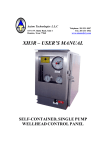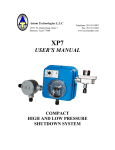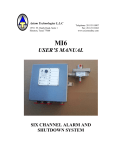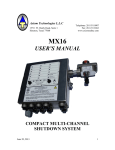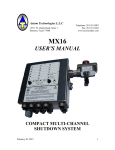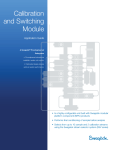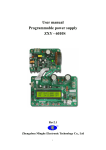Download USER`S MANUAL - Axiom Technologies, LLC
Transcript
Axiom Technologies L.L.C 15731 W. Hardy Road, Suite 7 Houston, Texas 77060 Telephone: 281 931 0907 Fax: 281 231 6562 www.axiomsafe ty.com XP3 USER’S MANUAL COMPACT HIGH AND LOW PRESSURE SHUTDOWN SYSTEM Axiom Technologies XP3 User’s Manual 15731 W. Hardy Rd., Suite 7, Houston, Texas 77060 Phone 281 931 0907 GENERAL The XP3 alarm and shutdown system is a self supported, compact shutdown device that has been designed to provide a safe and reliable mean to monitor temperature or pressure on a production process and initiate a shutdown if the reading exceeds the pre-set limits of operation. The system has been built to withstand the adverse conditions of the oil-field environment and provides a straightforward interface with the operator. Abnormal conditions are indicated by indicator lamps (LEDs), each associated with a label indicating the condition detected. Powered by lithium batteries, the system is expected to operate for about five years without replacing batteries and besides normal periodical functionality test there is little or no maintenance needed. INSTALLATION Typically, the XP3 is shipped with the battery module installed in the “storage position” for shipment. Remove the four studs holding the battery module, rotate the module 180º and carefully re-install as shown on page 7 of this manual. The XP3 is now energized and the green LED blinking once every two seconds. Indicator LEDs “Reset” – “Test” Switch Low Press/Temp Alarm Setting Solenoid Valve Sensing Port High Press/Temp Alarm Setting Fig. 1 XP3 General Layout The unit can be wall mounted or mounted directly on the process line. The box is provided with a small drain hole at the bottom to drain condensation. Do not mount the Manual Rev. 3E February 07, 2008 Page 2 OF 8 Axiom Technologies XP3 User’s Manual 15731 W. Hardy Rd., Suite 7, Houston, Texas 77060 Phone 281 931 0907 XP3 sideways or upside down as this may allow rainwater to ingress and accumulate in the enclosure. XP3 / Pressure Sensing Connect monitored pressure to Sensing Port. Sensed pressure is not to exceed 10% over full scale as this would cause damage in the instrument and void warranty. If the flow is prone to pressure spikes, a pulsation dampener is to be installed between the sensing port and sensed fluid. It is recommended that an isolation valve is installed between the sensing port and process to allow for maintenance and testing. NOTE: XP3 DEVICE IS TO BE MOUNTED UPRIGHT ON VERTICAL POSITION ONLY. NOTES: Do not exceed rated range. When connecting pressure bourdon assembly (bottom of XP3), dope or use teflon tape on connection threads. Use wrench on shank to tighten or loosen bourdon connection. Do not twist case when installing, this will damage internal components and void warranty. Do not over-tighten. Connecting the Solenoid Valve. The typical connection the solenoid valve is as follows Port 1 (normally closed) Port 2 (common) Port 3 (normally open) Supply Pneumatic Pressure (100 PSI Typ.) Actuator Exhaust Port No. 1 - Pneumatic Supply 100 PSI Typ. Port No. 2 - To Actuator. Note: Port numbers are stamped near the ports Port No. 3 - Exhaust Fig. 2 Solenoid pneumatic/hydraulic typical connection Manual Rev. 3E February 07, 2008 Page 3 OF 8 Axiom Technologies XP3 User’s Manual 15731 W. Hardy Rd., Suite 7, Houston, Texas 77060 Phone 281 931 0907 Adjusting High and Low limits Facing the dial, left knob adjusts the “Low Limit” while the “High Limit” contact is controlled by the knob on the right. To set the limit contacts simply turn the knob to the desired position in the scale. OPERATION The system can be commanded to “Reset” or “Test” by pressing the toggle switch up or down respectively. By pushing to “Reset” the operator commands the unit to return to the flowing condition while the “Test” function allows the operator to see the last recorded cause of shutdown (corresponding LED blinks fast) and then the system proceeds to slow blink each red LED to confirm all indicator circuits are operating normally. The system is shipped in the “RESET” condition. The needle of the gauge touching either the “Low” or “High” set point causes the XP3 to switch the solenoid valve into “shutdown”. The corresponding alarm LED will blink once a second to indicate the actual cause of the shutdown even if the alarm goes away or another alarm is later detected. EXAMPLE. If an XP3 senses a “High Pressure” in a production line it will cause a shutdown and the “High Pressure” LED will blink. After a number of hours, because of the shutdown, the sensed pressure may fall to the point where the high pressure clears and the needle of the gauge is now touching the low pressure alarm. In this case the XP3 will continue to flash the “High Pressure” alarm LED until the operator presses “Reset”. If the operator wants to confirm the cause of alarm, even after the system is back to normal, he just need to press “Test” and the XP3 will blink the “High Pressure” LED to show the last recorded cause of shutdown. After the XP3 is installed, the operator is to set the high and low alarm settings and open the isolation valve to allow pressure into the sensing port. If the gauge is on alarm at the time the operator presses “Reset” the existing alarm will be ignored for 30 minutes to allow the process to return to normal; there is no need to disturb the set-point before restoring the process. It is recommended not to move the set points out of the alarm condition as this involves the risk of the operator forgetting to return the alarms to the proper setting once the process returns to normal. If more than 30 minutes is needed then it is suggested that the operator presses “Reset” again before the time expires for re-starting the 30 minutes counting. If the pressure (or temperature) returns to normal before 30 the minutes expires, the XP3 will re-arm itself and will initiate shutdown again if an alarm is sensed. Manual Rev. 3E February 07, 2008 Page 4 OF 8 Axiom Technologies XP3 User’s Manual 15731 W. Hardy Rd., Suite 7, Houston, Texas 77060 Phone 281 931 0907 Time Delay Input The XP3 can be configured to have a 15 seconds time delay before initiating shutdown. This is mainly used in situations where the nature of the process causes pressure excursions that are not cause for shutdown if they last for just a couple of seconds. The time delay may be individually set by means of jumping JMP2 for having a delay on the Low Alarm and JMP1 for having a delay on the High Alarm. Each XP3 is shipped with the shunt connector attached to one pin on the jumper circuit (no time delay). To activate the time delay the operator is to install the shunt across the pins of JMP2 for the low pressure andJMP1 if the delay is to be set for the high pressure. Fig 3 JMP1 and JMP2 are located at the bottom left corner of control board. MAINTENANCE The XP3 requires little maintenance but a minimum of a monthly visual examination and testing is recommended to insure that the unit as well as the systems associated with the safety shutdown is operating properly. It is recommended that once a year the gauge pointer and High and Low limit points be cleaned with a non residue contact cleaner to insure optimum performance. Manual Rev. 3E February 07, 2008 Page 5 OF 8 Axiom Technologies XP3 User’s Manual 15731 W. Hardy Rd., Suite 7, Houston, Texas 77060 Phone 281 931 0907 Inspecting the XP3 The XP3 is to be examined periodically and operation may be confirmed by observing the “Syst.” LED for verifying it blinks every two seconds. (Sunny days may require the operator to shade the “Syst.” LED to see it blinking). The XP3 is to be inspected also to confirm that the face of the gauge is clean and the pressure/temperature indication is clearly visible. If evidence of contamination is seen on the needle of the gauge or set points, cleaning is needed to insure that contact will be made if an alarm condition is reached. To clean the contact points or needle use a soft cloth and contact cleaner fluid. Do not use abrasives materials or fluids as they will cause damage and reduce system’s reliability. Note Avoid opening the enclosure in a rainy or dusty environment. The batteries are expected to have a life of about 5 years before replacement is needed. The XP3 routinely read battery voltages and provides warning if the batteries need replacement. When the batteries are beginning to go low the XP3 will blink the “Lo Batt” LED to indicate that battery replacement is needed. If the batteries are not replaced within a few days the XP3 will cause a “Lo Batt.” shutdown as further reduction in voltage may prevent the system from protecting the process. WARNING - EXPLOSION HAZARD BATTERIES MUST ONLY BE CHANGED IN AN AREA KNOWN TO BE NON-HAZARDOUS. REPLACE BATTERY MODULE WITH AXIOM TECHNOLOGIES PART NUMBER AT-LBP-36144. Manual Rev. 3E February 07, 2008 Page 6 OF 8 Axiom Technologies XP3 User’s Manual 15731 W. Hardy Rd., Suite 7, Houston, Texas 77060 Phone 281 931 0907 REPLACING THE BATTERY MODULE Fig. 4 Remove screws from cover Fig. 5 Open front cover Fig. 6 Battery module is on top of box Fig. 7 Unscrew the four (4) nylon spacers holding the battery module. Fig. 8 Pull old battery module out and return for safe disposal. Fig. 9 Align the new battery module with threaded studs and push it in place gently. Manual Rev. 3E February 07, 2008 Page 7 OF 8 Axiom Technologies XP3 User’s Manual 15731 W. Hardy Rd., Suite 7, Houston, Texas 77060 Fig. 10 Re-install nylon spacers to hold the battery module in place. Tighten by hand only. Phone 281 931 0907 Fig. 11 Cover is to be closed and secured with front screws to insure proper sealing and protection from environment . WARNING DO NOT ATTEMPT TO RECHARGE BATTERY MODULE AS THIS MAY TRIGGER AN UNSTABLE CONDITION WITHIN THE LITHIUM CELLS AND CAUSE AN EXPLOSION Return used battery modules to Axiom Technologies for safe disposal. XP3 - ENVIRONMENTAL SPECIFICATIONS Temperature range Humidity range Altitude Hazardous Area Classification : : : : -40 to +60C 0 To 95% max., non condensing 2,000 m. max. Suitable for Class I, Division 2, Groups C & D, Hazardous Locations. Temp. code T3C XP3 - PRESSURE RATINGS Sensing Pressure : Ranges of up to 20,000 psi max Solenoid Valve Pressure : 100 psi max. (standard ), up to150 psi available XP3 - ELECTRICAL RATINGS Electrical Source : Dual voltage lithium battery module3.6 & 14.4 VDC Current consumption : 285 mA max. on 3.6VDC Circuits 435 mA (3 A max. pulse) on 14.4VDC Circuits Manual Rev. 3E February 07, 2008 Page 8 OF 8








